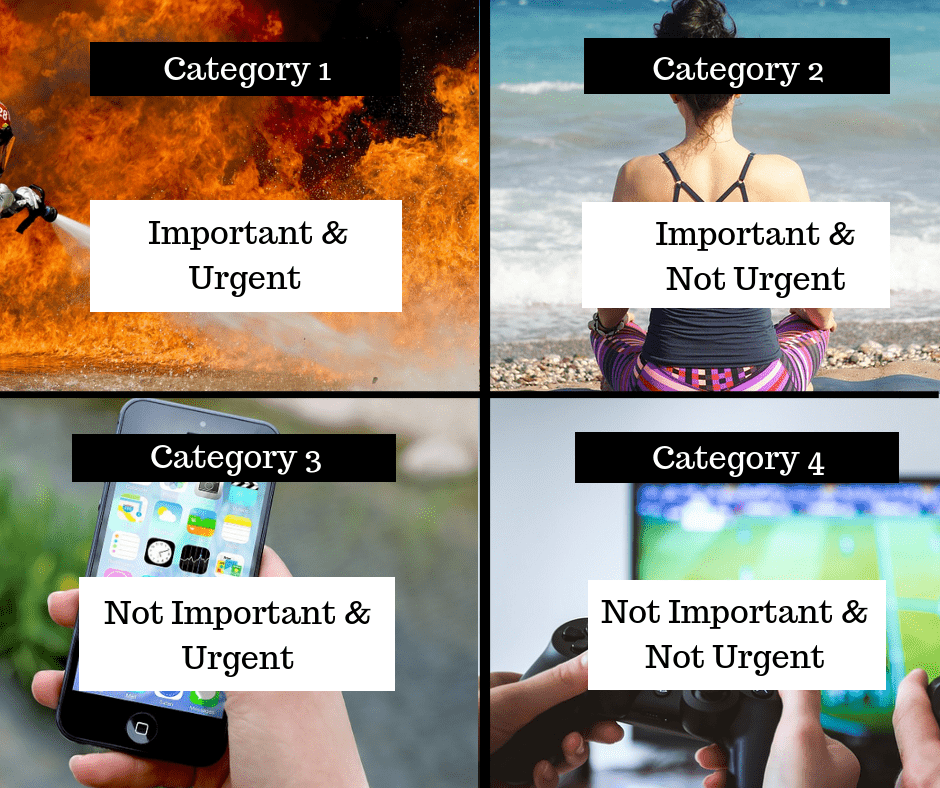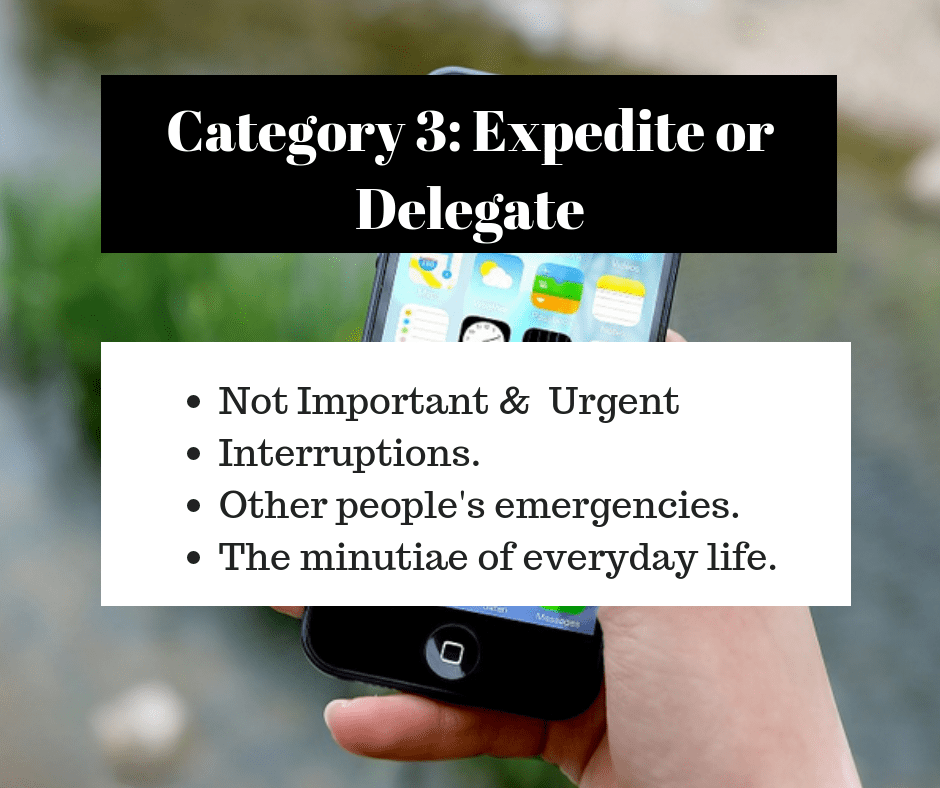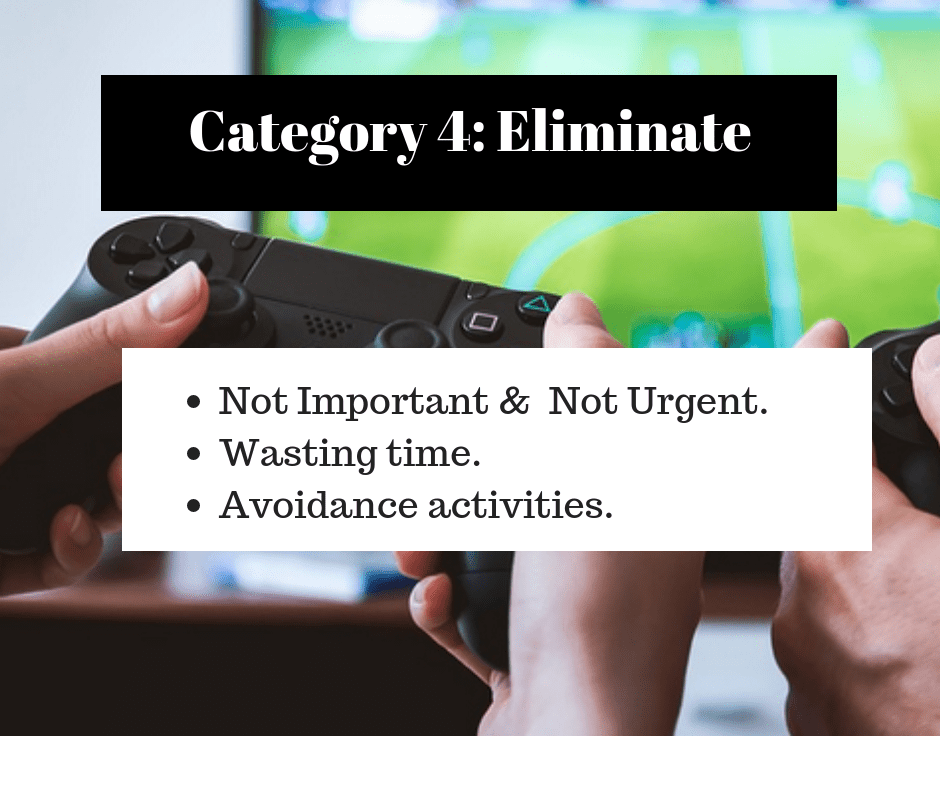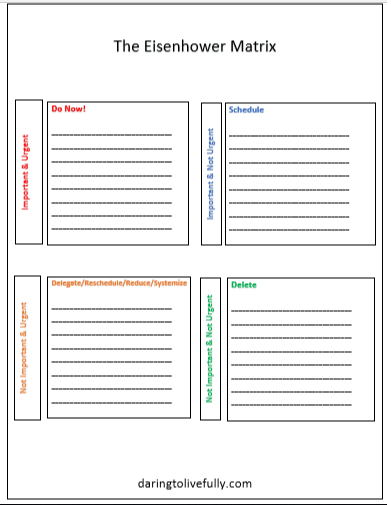
The key to making the best use of your time is to prioritize your tasks.
 Lots of people create to do lists; then, they get to work on the activities on the list in an indiscriminate order. As a result, they tend to be busy all day long but without achieving meaningful results. After all, not all tasks are created equal.
Lots of people create to do lists; then, they get to work on the activities on the list in an indiscriminate order. As a result, they tend to be busy all day long but without achieving meaningful results. After all, not all tasks are created equal.
Enter the Eisenhower Matrix, a tool which will help you to prioritize tasks by urgency and importance. This matrix was first proposed by Dwight Eisenhower, the 34th president of the United States of America. President Eisenhower once said the following:
“I have two kinds of problems: the urgent and the important. The urgent are not important, and the important are never urgent.”
This insight led him to come up with what is referred to as the Eisenhower Principle. He recognized that he needed to use his time in a way that was both efficient and effective. In addition, the way to do that was by not allowing the urgent to get in the way of what was most important.
In this post I’m going to explain what the Eisenhower Matrix is, and I’m going to give you strategies on how to start applying it in your own life in order to make the best use of your time.
The Eisenhower Matrix In a Nutshell
As I explained above, President Eisenhower planned his days along the dimensions of urgency and importance. Here’s the distinction between the two:
- Important activities are those that will allow us to achieve our goals and dreams, as well as live in accordance with our values. One way to decide if a task is important is to ask yourself the following: “Can I reach my goals and stay true to my values if I skip this task?”
- Urgent activities are those that have a looming deadline. One way to decide if a task is urgent is to ask yourself: “When is the deadline for this task?” As I explain further down below, just because something is urgent doesn’t necessarily mean you should do it.
Given these two dimensions–important and urgent–, activities can fall into one of the four categories of the Eisenhower Matrix:
- Category 1: Important and Urgent
- Category 2: Important and Not Urgent
- Category 3: Not Important and Urgent
- Category 4: Not Important and Not Urgent
This gives us the following matrix:

You’ll find an explanation of each of these categories below.
Category 1: Important and Urgent
The first category of the Eisenhower Matrix–important and urgent–consists of firefighting. It’s where a lot of people spend most of their time.

Tasks that fall into Category 1 require our immediate attention. When it comes time to decide which items on your to do list you should do first, start with these. If you don’t get to work on these items, one of two things will happen:
- There will be a negative consequence–for example, your boss will yell at you for not handing in the financial report on time.
- You’ll miss an important opportunity–as an illustration, if you fail to deliver the grant application on time, you won’t be able to compete for the grant prize.
If many of the tasks on your to do list fall into this category, you’re constantly in troubleshooting mode. This can be very stressful, and it will interfere with your ability to work on your long-term goals.
There are two main reasons why activities end up in this category:
- You procrastinated on an important project or task.
- Something unforeseen took place.
Category 1 Examples
Some examples of things that fall into this category include the following:
- It’s Tuesday, you have a test on Friday, but you haven’t even started studying.
- It rained heavily and now your basement is flooded.
- You have to give a presentation to the board of directors in two days, but you haven’t gathered all of the necessary data.
- Your website was hacked.
- You get a call from your kid’s school saying that he’s sick and you need to go pick him up.
How to Reduce Category 1 Tasks
Your strategy when it comes to Category 1 should be to try to reduce the number of tasks that fall into this category, with the goal of keeping them to a bare minimum. Here are five things you can do to reduce the amount of time that you spend in this category:
- Learn project management so that you can complete your projects in an efficient and timely manner.
- Practice prevention: exercise; eat healthy meals; follow a schedule of regular maintenance for your car and important household appliances; and so on.
- Set yearly, monthly, and weekly goals.
- Plan each day the night before. Then, every morning, review your plan.
- Take steps to overcome procrastination.
Category 2: Important and Not Urgent
This is the category where your values and your dreams live. Unfortunately, it’s often neglected because you allow tasks that fall into the other three categories to eat away at your time.

When you’re prioritizing your to do list, make sure to schedule a time and place for Category 2 activities. Then, make an unbreakable commitment to yourself to work on these tasks, even if they don’t come with a sense of urgency.
This category is where the magic happens. Tasks that fall into this category are those that will allow you to achieve your long-term goals in all life areas, as well as prevent fires that you then have to put out in Category 1. In addition, it’s a pretty stress-free category.
Category 2 Examples
Some examples of things that fall into this category of the Eisenhower Matrix include the following:
- Personal development–reading books on personal development, attending seminars, and taking online courses.
- Strategizing sessions.
- Learning new skills–learning to code, learning another language, or acquiring business skills.
- Improving vital skills.
- Exercising.
- Meditating, doing yoga, or doing Tai Chi.
- Taking scheduled breaks.
- Spending time with your kids.
- Going on dates with your spouse.
- Creating a crisis management protocol for your business.
- Improving systems.
- Practicing self-care.
- True recreation.
- Working on a rewarding hobby.
- Preparing to change careers.
- Working on your novel.
- Creating a second source of income.
- Taking steps to prevent the crises that put you in Category 1.
- Working on an important project in a timely manner.
If this category is so great, why don’t people spend most of their time here? Because these activities tend to be pushed to the side by tasks and activities that fall into the other three categories. In addition, the consequences of not doing Category 2 activities don’t appear right away.
How to Spend More Time in Category 2
If you want to spend more time in Category 2, you must do so deliberately. Here are five things you can do to spend more time on activities that fall in this category:
- Set goals–set short-term, mid-term, and long-term goals.
- Be clear on your values.
- Set aside one-hour-a-day to work on your most important goals.
- Create fake deadlines for Category 2 activities and look for ways to hold yourself accountable to those deadlines.
- Follow the advice contained in this article for reducing the amount of time that you spend on activities that fall into Categories 1, 3, and 5. Apply that freed up time to Category 2 tasks.
Category 3: Not Important and Urgent
Tasks that fall into Category 3 of the Eisenhower Matrix can be very seductive, because they usually come with bells and whistles. The urgency of these tasks can make them feel important, even if they’re not.

You probably spend a lot of time in this category if you often hear yourself saying things like the following:
- “I was busy all day, but I didn’t accomplish anything of importance.”
- “I’m exhausted, but I feel like I have nothing to show for it.”
To stop feeling this way, look for ways to limit the tasks that fall into this category as much as you can.
Category 3 Examples
Examples of tasks that fall into this category include the following:
- Interruptions, such as the doorbell ringing or a notification popping up on your computer screen.
- Other people’s emergencies.
- Household chores.
- Some phone calls and meetings.
The best way to deal with these activities is to postpone them, delegate them, outsource them, eliminate them, or give them a chunk of time and try to finish them as quickly as you can.
How to Reduce Category 3 Tasks
Here are five things you can do to spend less time in this category:
- Set your own agenda and your own priorities so that you’re not constantly working on the agenda and priorities of others.
- Learn to say “no” politely but firmly.
- Delegate and outsource tasks that fall into this category.
- Create systems to deal with tasks such as house cleaning and doing the laundry as efficiently and quickly as possible.
- Find a quiet space to work where you won’t be interrupted and turn off all distractions.
Category 4: Not Important and Not Urgent
Tasks that fall into this category are simply a waste of time and should be avoided at all costs.

Although tasks that fall into this category are simply time wasters, people engage in them for a variety of reasons. Here are some of them:
- Lack of concentration–e.g., you lose your focus and find yourself reading articles on topics that are not related to the task you were working on.
- Low levels of dopamine–if your levels of dopamine are low you may find yourself engaging in what you perceive to be pleasurable activities to try to raise your levels of this important neurotransmitter.
- To avoid the discomfort of working on difficult tasks.
- Negative habits — for example, you may have created a habit of clicking on the Instagram icon every so often, and now you do it on autopilot.
- Burnout–you’re too stressed and tired to work on important things that require lots of brain power.
Category 4 Examples
Examples of tasks that fall into this category include the following:
- Busywork, such as excessive formatting and creating unnecessary reports.
- Checking your email constantly.
- Going on social media countless times throughout the day.
- Avoiding difficult tasks by aimlessly searching the web, mindlessly watching TV, playing video games for hours on end, or organizing your desk for the umpteenth time.
- Some phone calls and meetings.
- Gossiping around the water cooler.
- Checking the news repeatedly throughout the day.
How to Reduce Category 4 Tasks
Here are five things you can do to spend less time in this category:
- Designate a time for checking email and social media. If you feel the need to go on Twitter or open your inbox, remind yourself that you’ve set time aside for that later.
- Block out chunks of time for important tasks. When it’s time to work on those tasks you only have two options: work on the task or stare at your thumbs.
- Schedule time for fun and relaxation so that you’re less tempted to escape by spending time on Category 4 activities.
- Make a list of the ways in which you waste time so that you can catch yourself when you’re engaging in any of these activities.
- Create a clear structure for your day so that you don’t accidently wander into Category 4 (it happens).
Methodology to Follow
I hope that it’s clear from the explanations above of each of the four categories of the Eisenhower Matrix that prioritizing your tasks is vital for your success. Here’s a ten-step process you should follow:
1. Make a list of all the tasks that you have to complete throughout the day.
2. Go through each task and ask these two questions: “Is this important?” and “Is this urgent?” Your list could look something like the following:
 3. Depending on the answers to the two questions above, put each task in one of the four categories of the Eisenhower Matrix. You can download the PDF below and use that.
3. Depending on the answers to the two questions above, put each task in one of the four categories of the Eisenhower Matrix. You can download the PDF below and use that.

4. Take out your agenda, day book, calendar, or whatever you use to organize your day. Schedule tasks that fall into Category 2.
5. Eliminate, postpone, or delegate any tasks that fall into Category 3. If you have to deal with these tasks, schedule a time to work on them as expeditiously as possible.
6. Delete all Category 4 tasks.
7- Now that your day is planned, get going. Eat the frog and get to work on Category 1 activities — start with the most urgent one.
8. Devise a strategy for spending as much time as possible on Category 2 activities by following the recommendations found in this article.
9. Apply the strategy that you come up with.
10 Reevaluate in a month’s time.
Conclusion
Organize your life in a way that will allow you to spend most of your time working on those things which are conducive to the achievement of your goals. The matrix created by President Eisenhower is a great tool for doing this. Live your best life by prioritizing your tasks with the Eisenhower Matrix.





Related Posts:




 Marelisa Fabrega is a lawyer and entrepreneur. She holds a Bachelor of Science in Business Administration from Georgetown University in Washington, D.C., as well as a Juris Doctor from the Georgetown University Law Center. You can learn more about her
Marelisa Fabrega is a lawyer and entrepreneur. She holds a Bachelor of Science in Business Administration from Georgetown University in Washington, D.C., as well as a Juris Doctor from the Georgetown University Law Center. You can learn more about her 





